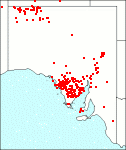Family: Poaceae
Triodia irritans
Citation:
R. Br., Prod. Fl. Nov. Holl. 182 (1810).
Synonymy: Triodia aristata Common name: None
Description:
Tussocks usually dense, but sometimes spreading or dying back in the centre; leaf blades glabrous, 8-20 cm long, the sheaths glabrous or hairy, or very minutely pubescent, rather loose.
Panicle narrow, dense or slightly loose, 8-20 cm long, the branches with few spikelets, erect, the lower ones 2-5 cm long; spikelets 4-12-flowered, oblong-lanceolate or ovate, 12-20 mm long, mostly on long slender pedicels; glumes glabrous, stiff and shining, 8-11 mm long, obscurely 5-7-nerved; lemmas 7-8 mm long, c. 9-nerved in 3 sets, with 2 rounded ciliolate short lateral lobes and a mucro between them, which may be shorter than the lobes or exceed them by 1-2 mm, the lower part of the lemmas densely silky-villous on the nerves; palea as long, ciliate on the 2 nerves and often villous towards the base of the nerves.
Published illustration:
Lazarides (1970) The grasses of Central Australia, pl. 6lb.
|
|
Distribution:
|
S.Aust.: NW, LE, NU, GT, FR, EP, NL, SL.
|
Conservation status:
native
Flowering time: No flowering time is available |

SA Distribution Map based
on current data relating to
specimens held in the
State Herbarium of South Australia
|
Biology:
No text
Taxonomic notes:
The varieties are difficult to distinguish (see key to species).
Key to Infraspecific taxa:
Author:
Not yet available
|

